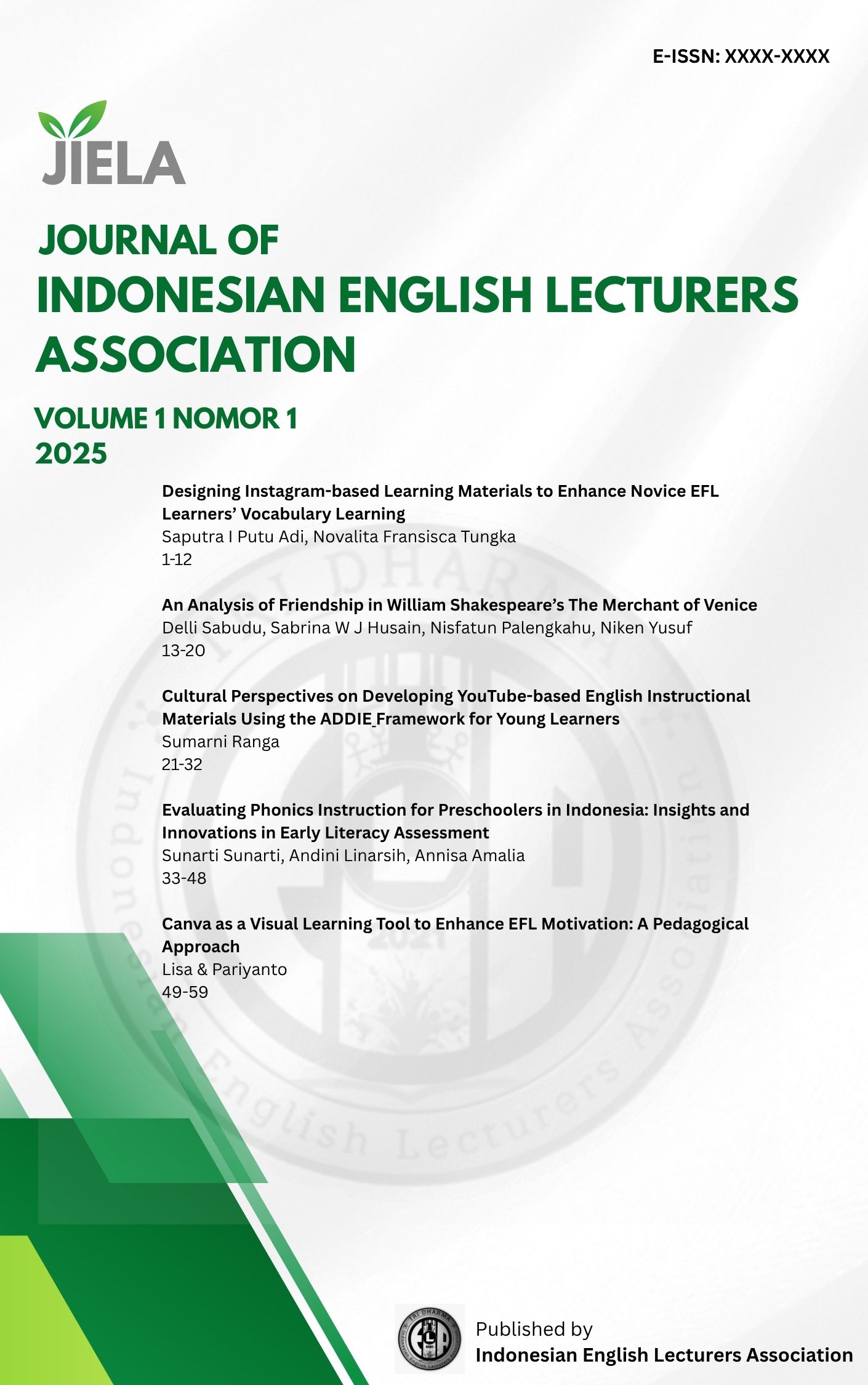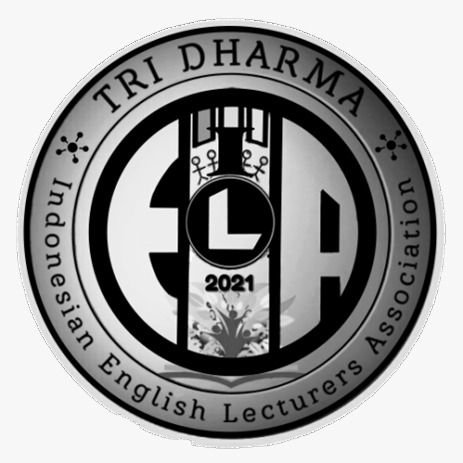Cultural Perspectives on Developing YouTube-based English Instructional Materials Using the ADDIE Framework for Young Learners
Keywords:
R &D, English instructional materials, young learners, vocabulary, ADDIEAbstract
This study discusses the integration of cultural perspectives in developing YouTube-based English instructional materials for young learners in under-resourced contexts using the ADDIE framework and the Cultural-Historical Activity Theory. This study addresses the gap in existing studies on culturally responsive pedagogy by investigating how cultural relevance can be systematically embedded into each phase of instructional design with the use of YouTube as the primary platform for content delivery. The study details the procedural steps in creating culturally sensitive educational materials for students at SD Negeri 1 Taripa, Tiu Village, Poso Regency, Central Sulawesi Province. The data were gathered through surveys, interviews, and focus group discussions with one teacher and the students and were analyzed qualitatively. Through needs assessment, content development, multimedia implementation, and formative evaluation, the study found that culturally contextualized materials significantly enhanced student motivation, engagement, and vocabulary acquisition in under-resourced contexts. This study is limited by its small sample, short duration, and partial execution of the Evaluation phase, which may limit the broader applicability of the cultural perspectives using the ADDIE framework. Future research is needed to explore its applicability across different age groups, educational settings, teacher trainings, and cultural backgrounds.
References
Audina, I. P., Suwastini, N. K. A., Jayantini, I. G. A. S. R., Dantes, G. R., & Rusnalasari, Z. D. (2022). Youtube Videos As Learning Media: A Review In Efl Contexts. 11(2), 220–232. https://doi.org/https://doi.org/10.15642/ijet2.2022.11.2.220-232.
Branch, R. M. (2010). Instructional design: The ADDIE approach. In Instructional Design: The ADDIE Approach. Springer US. https://doi.org/10.1007/978-0-387-09506-6.
Cahyadi, R. A. H. (2019). Pengembangan bahan ajar berbasis Addie model. Halaqa: Islamic Education Journal, 3(1), 35–42. https://doi.org/10.21070/halaqa.v3i1.2124.
Creswell, J. W. (2012). Educational Research Planning, Conducting, and Evaluating Quantitative and Qualitative Research (4th ed.). Pearson Education, Inc.
Kao, I., Chang, C., & Yen, W. (2022). YouTuber’s Video as Cross-Cultural Learning Resource for Chinese-as-Foreign-Language Learners – Perspective of Big `C’ and Small `c’ Culture. In S.-C. and B. J. and S. F. E. Huang Yueh-Min and Cheng (Ed.), Innovative Technologies and Learning (pp. 262–271). Springer International Publishing.
Magdalena, I., Prabandani, R. O., Rini, E. S., Fitriani, M. A., & Putri, A. A. (2020). Analisis Pengembangan Bahan Ajar. Jurnal Pendidikan Dan Ilmu Sosial, 2(2), 170–187. https://doi.org/https://doi.org/10.36088/nusantara.v2i2.805
Michael, E. A., & Mohd. Shah, P. (2020). Students’ Perception on YouTube Usage in Rural ESL Classroom. International Journal of Academic Research in Business and Social Sciences, 10(3), 410–431. https://doi.org/10.6007/ijarbss/v10-i3/7059
Muhajir, F. F., Tjahjono, B., & Munawar, B. (2022). Desain Pengembangan Bahan Ajar Digital Berbantuan Aplikasi Animaker Pada Mata Kuliah Pendidikan TIK (Teknologi Informasi dan Komunikasi). JTKSI (Jurnal Teknologi Komputer Dan Sistem Informasi), 5(2), 87–93. https://doi.org/https://doi.org/10.56327/jtksi.v5i2.1134
Muslem, A., Fata, I. A., & Saputri, W. I. (2022). The Effect of English Authentic Youtube Videos on Students’ Speaking Skills in Rural School. Journal of Education Technology, 6(3), 423–430. https://doi.org/10.23887/jet.v6i3.454
Sari, E., & Tungka, N. F. (2023). The Relationship between Digital Literacy Skills and Self-Regulated Learning Skills of English Language Education Students. Sintuwu Maroso Journal of English Teaching, 9(1), 1–5. https://ojs.unsimar.ac.id/index.php/sintuwumarosoJET/article/view/547
Syafira, S. D., Fauziah, N., Iswanto, A., Febrianisa, Z., Ansori, K. A., Salwa, S. E., Abdurahman, A., & Binasdevi, M. (2024). Pengembangan Media Komik digital Untuk Mendukung Pembelajaran Di Era Digital Tingkat Sekolah Dasar. Academicus: Journal of Teaching and Learning, 3(2), 90–98. https://doi.org/10.59373/academicus.v3i2.58
Vygotsky, L. S. (1978). Development of Higher Psychological Processes (M. Cole, V. Jolm-Steiner, S. Scribner, & E. Souberman, Eds.). Harvard University Press. https://doi.org/10.2307/j.ctvjf9vz4
Yang, Y.-T. C., & Wu, W.-C. I. (2012). Digital storytelling for enhancing student academic achievement, critical thinking, and learning motivation: A year-long experimental study. Computers & Education, 59(2), 339–352. https://doi.org/10.1016/j.compedu.2011.12.012
Zulkarnaini, Megawati, C., Astini, D., & Syahputra, I. (2022). Penggunaan Model ADDIE dalam Pengembangan Bahan Ajar. BAKTIMAS Jurnal Pengabdian Pada Masyarakat, 4(2), 77–80. https://ojs.serambimekkah.ac.id/BAKTIMAS/article/view/4782
Downloads
Published
Issue
Section
License
Copyright (c) 2025 Journal of Indonesian English Lecturers Association (JIELA)

This work is licensed under a Creative Commons Attribution 4.0 International License.







